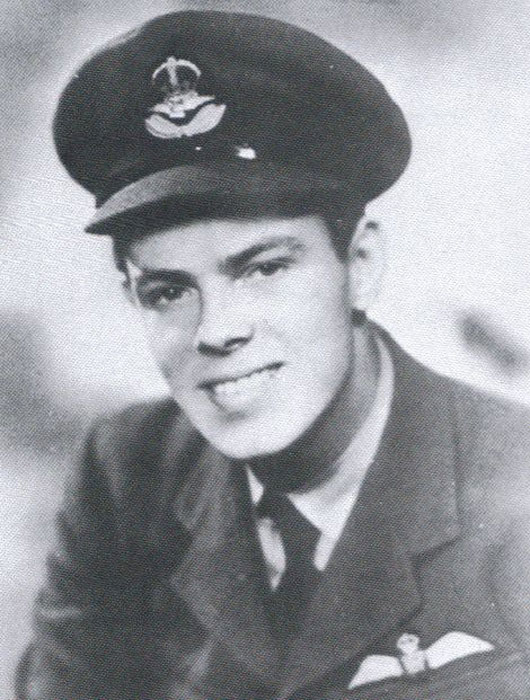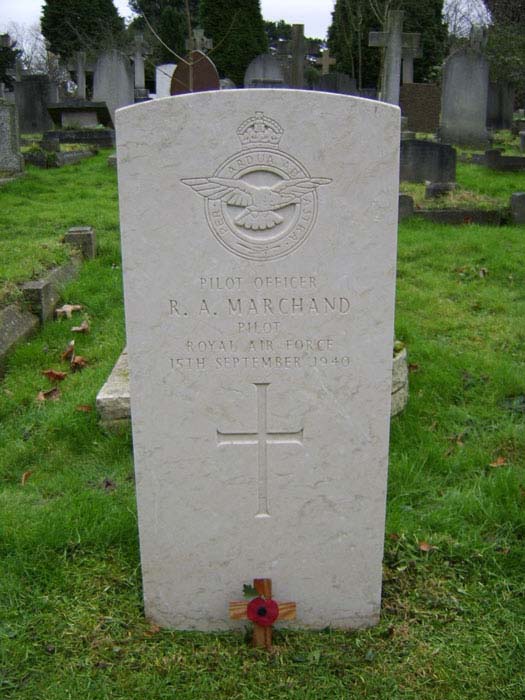The Airmen's Stories - P/O R A Marchand
Roy Achille Marchand was born in Bromley, Kent on 24th August 1918, the son of Rene Achille Marchand and Constance Jane Marchand (nee Dean).
His father was from a Swiss watchmaking family, he came to Britain in 1910 and founded a watch company that made artillery shell fuzes in WW1. He had married Constance Dean in the Swiss Church in London in April 1916.
After leaving Westminster School in 1936, Roy Marchand began to study medicine at King’s College, London University. His desire for a flying career in the Royal Air Force was ignited after meeting a serving RAF Squadron Leader whilst holidaying in the South of France in 1938.
Marchand joined the RAF on a short service commission in March 1939 and he began his training at 30 Elementary & Reserve Flying Training School at Burnaston near Derby. Further training followed at 15 FTS Lossiemouth and he was awarded his wings in August 1939.
A posting to 11 Group Pool on 20th November for further training resulted in attachment to the 2 Ferry Pilot Pool as a reserve pilot for France.

He was soon serving with 73 Squadron, operating Hurricanes at Rouvres.
Marchand was credited with Messerschmitts destroyed on 26th March and 21st April, 1940.
On 13th May four Hurricanes from the squadron engaged a Do17 of 3(F)/122 near Rheims. All were hit by return fire, Marchand's L1673 being hit in the oil and glycol tanks. He force-landed near Bethenville with a shoulder wound and perspex splinters in his left eye. He was evacuated to the UK for treatment. During his convalescence he married Jean Angela Cullen in Bromley, Kent.
However he and his new wife were badly hurt in a car accident and were in hospital for three weeks.
Marchand was back with 73 on 6th July, now at Church Fenton in North Yorkshire where it was recuperating and re-equipping. They were sent south on 5th September, firstly to Debden in 12 Group but then to its satellite, Castle Camps. They were in action the same day.

The following day, the 6th September, Marchand claimed a Me109 probably destroyed and this was recorded in the squadron ORB:
P/O Marchand destroyed a 109, 10 miles NE of MAIDSTONE, thus opening the Squadron’s score in that category. He landed at PENSHURST having run short of petrol and rather lost his way. He got back in the evening his smiles even as large as if his wife had walked suddenly into Freddie 1 (the airfield's code name). It was a tonic to see him but when he came to make out his individual combat report, the IO noticed that he had only claimed a ‘probable’. Even more pleased was he when told it obviously came into the ‘destroyed’ class and he was the first to get a definite kill for 73 Squadron.
There was an amusing incident in the early evening of the 8th when an unidentified aircraft was plotted in the vicinity of Castle Camps. Concern grew among those on the ground, for when challenged the intruder fired off the wrong colours of the day - Sgt. J Griffin was ordered to rapidly get airborne in his Hurricane and investigate the ‘intruder’. After a short time, due to radio problems, he landed and reported verbally that the aircraft was a “long nosed” Blenheim. S/Ldr. Robinson passed on this information to Operations, who responded by ordering two more 73 Squadron Hurricanes to take off and investigate. The diary records:
The Mess was a rush of eager applicants but eventually F/Lt. Beytagh and P/O Marchand were the winners and were airborne in less than 3 minutes minus helmets. They intercepted beautifully some 3 miles to the West of the aerodrome in full view of all of us and amid cheers and shouts of ironical advice, whereupon the ‘Blenheim’ shot off the correct colours in great haste! On their return the two pilots reported that it was an Anson whereupon Sgt. Griffin was ‘debagged’ outside the mess and drinks all round were demanded from him – incidentally without success.
On the 11th Marchand claimed a probable Me110.
On the critical day of the Battle, 15th September, 73 Squadron were on standby from dawn till until just after 1100 hours when ten Hurricanes, including Marchand, were ordered off to patrol Chelmsford at 15000 feet. Not being at full strength, Blue and Green Sections of ‘B’ Flight comprised the main formation leaving the 4 remaining Hurricanes to act as lookouts. They soon engaged a large force of Me109s above Maidstone.
Lack of fuel and ammunition caused the Hurricanes to break off one by one and return to Castle Camps where all but Marchand were accounted for. A report was received saying that he had force-landed at Biggin Hill.
It was only that evening, after an afternoon combat, that a signal was received resulting in the ORB entry:
... we were astounded to be told that he had crashed at TYNHAM [sic] near SITTINGBOURNE and killed.”
The sadness felt by everyone was intensified by the fact that his pregnant wife had been waiting at the squadron dispersal for her husband. The unpleasant task of breaking the news to her fell to F/O Michael Beytagh [as acting Commanding Officer] along with P/O Hoole, the Intelligence Officer. The squadron diary later recorded:
P/O Marchand was an excellent pilot and a charming and unassuming boy who was never ruffled by anybody or anything. We will sorely miss him.
The record for the day was closed with the words:
The Squadron feels that to some extent the death of gallant Marchand to-day has been avenged by the day’s good work.
P/O Marchand was buried at Bromley Hill Cemetery where for many years his grave was marked by a magnificent polished granite headstone. This was later moved to an air museum and replaced by a CWGC headstone (below).

When the museum closed down the stone was obtained by the Tangmere Military Aviation Museum who felt that a more suitable location was the crash site. With the cooperation of Mr & Mrs Rex Boucher, the owners of Nouds Farm, Lynsted and the agreement of Marchand's daughter Mrs. Carol Ventura the stone was installed on 15th September, 1985.


At this spot each year the local branch of the Royal Air Force Association holds its Battle of Britain service.
Additional research courtesy of Dean Sumner 2008.
***************************
January 2024 - Daniel Everett of the Swiss Church in London kindly sent this image of a memorial plaque in the church where Roy's parents were married.

The inscription reads:
In Memory of
Fighter Pilot Roy Marchand
"One of the Few"
Died in air combat on 15th September 1940
and to his compatriots who sacrificed
their lives for a better world.
Spring 1940
"Let your heart not be troubled, believe in God and believe in me"
(John 14:1)
|